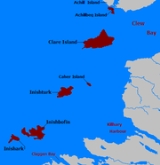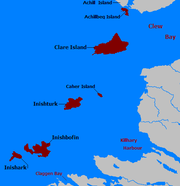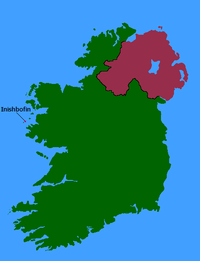
Inishbofin, Galway
Encyclopedia
Inishbofin is an island lying about 8 kilometres (5 mi) off the coast of Connemara
, County Galway
, Ireland
. It is about 5.5 km (3½ mi) long and 3 km (1.9 mi) wide, and has around 200 inhabitants. The island is popular with artists. Inishbofin can be reached by ferry
from the pier in Cleggan
. There is also a helipad, and an airstrip has been built on the island. There are three hotels on the island, Day's Inishbofin House Hotel, Murray's Doonmore Hotel and the Dolphin Hotel, as well as a hostel. A community centre includes a small island library. Inishbofin hosted the 2008 All-Ireland Islands Football Tournament.
 The island's English name Inishbofin is derived from the Irish name Inis Bó Finne (Island of the White Cow). The name has its origins in a local legend. The island has been occupied continuously since the Bronze Age. In 668, Saint Colmán
The island's English name Inishbofin is derived from the Irish name Inis Bó Finne (Island of the White Cow). The name has its origins in a local legend. The island has been occupied continuously since the Bronze Age. In 668, Saint Colmán
founded a monastery on Inishbofin which survived until the 10th century. It is also home to the ruins of Cromwell
's barracks, constructed in 1652. When the much hated Cromwell was in power, Inishbofin was transformed into a penal colony for Catholic
clergy. An unfortunate bishop was tied to "Bishop's Rock" at low tide and drowned as the waters rose.
 Inishbofin is also home to Dún Gráinne, the remains of a fort used by the legendary Gráinne O'Malley, Ireland's pirate queen, as well as the ruins of a Celt
Inishbofin is also home to Dún Gráinne, the remains of a fort used by the legendary Gráinne O'Malley, Ireland's pirate queen, as well as the ruins of a Celt
ic fort dating to 1000 B.C. Inishbofin is believed to have been continuously inhabited for up to 10,000 years.http://www.inishbofin.com/ Islanders refer to the fort, which is a good example of a 17th century 'star' fort as 'Oliver Cromwell
's Fort'. It was built in the 1650s during the Cromwellian wars
to command the harbour entrance. Inishbofin was one of the most important shipping havens on the West coast of Ireland in the days of sail. It was one of the last Royalist strongholds to fall to Cromwell's army and was garrisoned by them until the end of the century. The Cromwellians used it as a staging post for Irish men and women who were being transported to the West Indies.
The current population of approximately 200 is down from a historical high of over 1000 in the 1840s.
An aspect of the island is that it has no trees or forests whatsoever. Any wood was cut down and used as heating fuel. Because of the salt-enriched air, trees were never able to re-establish themselves.
Instead, a popular fuel on the island is peat
turf. Cut from peat bogs, the turf is dried and makes a pleasant-smelling fire. There are currently 182 people living on the Island.
Inishbofin is mentioned at some length by Irish author Robert Gibbings
, writing in 1946. He also mentions in passing some Inishbofin placenames that appear to be no longer extant, suggesting that the villages have now vanished. These include: Alladoon, Bunamullen, Cooltra, Mweelanbwee, Ooghnagunnel.
Nobel Laureate Seamus Heaney's poem "Seeing Things" (published in 1991 collection by the same name) begins with a boat ride to Inishbofin. "Inishbofin on a Sunday Morning. / Sunlight, turfsmoke, seagulls, boatslip, diesel."
Connemara
Connemara is a district in the west of Ireland consisting of a broad peninsula between Killary Harbour and Kilkieran Bay in the west of County Galway.-Overview:...
, County Galway
County Galway
County Galway is a county in Ireland. It is located in the West Region and is also part of the province of Connacht. It is named after the city of Galway. Galway County Council is the local authority for the county. There are several strongly Irish-speaking areas in the west of the county...
, Ireland
Ireland
Ireland is an island to the northwest of continental Europe. It is the third-largest island in Europe and the twentieth-largest island on Earth...
. It is about 5.5 km (3½ mi) long and 3 km (1.9 mi) wide, and has around 200 inhabitants. The island is popular with artists. Inishbofin can be reached by ferry
Ferry
A ferry is a form of transportation, usually a boat, but sometimes a ship, used to carry primarily passengers, and sometimes vehicles and cargo as well, across a body of water. Most ferries operate on regular, frequent, return services...
from the pier in Cleggan
Cleggan
Cleggan is a picturesque fishing village in County Galway, Ireland. The village lies 10 km northwest of Clifden and is situated at the head of Cleggan Bay....
. There is also a helipad, and an airstrip has been built on the island. There are three hotels on the island, Day's Inishbofin House Hotel, Murray's Doonmore Hotel and the Dolphin Hotel, as well as a hostel. A community centre includes a small island library. Inishbofin hosted the 2008 All-Ireland Islands Football Tournament.
History

Colmán of Lindisfarne
Colmán of Lindisfarne also known as Saint Colmán was Bishop of Lindisfarne from 661 until 664. He succeeded Aidan and Finan. Colman resigned the Bishopric of Lindisfarne after the Synod of Whitby called by King Oswiu of Northumbria decided to calculate Easter using the method of the First...
founded a monastery on Inishbofin which survived until the 10th century. It is also home to the ruins of Cromwell
Oliver Cromwell
Oliver Cromwell was an English military and political leader who overthrew the English monarchy and temporarily turned England into a republican Commonwealth, and served as Lord Protector of England, Scotland, and Ireland....
's barracks, constructed in 1652. When the much hated Cromwell was in power, Inishbofin was transformed into a penal colony for Catholic
Catholic
The word catholic comes from the Greek phrase , meaning "on the whole," "according to the whole" or "in general", and is a combination of the Greek words meaning "about" and meaning "whole"...
clergy. An unfortunate bishop was tied to "Bishop's Rock" at low tide and drowned as the waters rose.

Celt
The Celts were a diverse group of tribal societies in Iron Age and Roman-era Europe who spoke Celtic languages.The earliest archaeological culture commonly accepted as Celtic, or rather Proto-Celtic, was the central European Hallstatt culture , named for the rich grave finds in Hallstatt, Austria....
ic fort dating to 1000 B.C. Inishbofin is believed to have been continuously inhabited for up to 10,000 years.http://www.inishbofin.com/ Islanders refer to the fort, which is a good example of a 17th century 'star' fort as 'Oliver Cromwell
Oliver Cromwell
Oliver Cromwell was an English military and political leader who overthrew the English monarchy and temporarily turned England into a republican Commonwealth, and served as Lord Protector of England, Scotland, and Ireland....
's Fort'. It was built in the 1650s during the Cromwellian wars
Cromwellian conquest of Ireland
The Cromwellian conquest of Ireland refers to the conquest of Ireland by the forces of the English Parliament, led by Oliver Cromwell during the Wars of the Three Kingdoms. Cromwell landed in Ireland with his New Model Army on behalf of England's Rump Parliament in 1649...
to command the harbour entrance. Inishbofin was one of the most important shipping havens on the West coast of Ireland in the days of sail. It was one of the last Royalist strongholds to fall to Cromwell's army and was garrisoned by them until the end of the century. The Cromwellians used it as a staging post for Irish men and women who were being transported to the West Indies.
The current population of approximately 200 is down from a historical high of over 1000 in the 1840s.
An aspect of the island is that it has no trees or forests whatsoever. Any wood was cut down and used as heating fuel. Because of the salt-enriched air, trees were never able to re-establish themselves.
Instead, a popular fuel on the island is peat
Peat
Peat is an accumulation of partially decayed vegetation matter or histosol. Peat forms in wetland bogs, moors, muskegs, pocosins, mires, and peat swamp forests. Peat is harvested as an important source of fuel in certain parts of the world...
turf. Cut from peat bogs, the turf is dried and makes a pleasant-smelling fire. There are currently 182 people living on the Island.
Literature
Mid 20th-century life on Inishbofin was chronicled in a book written by Deborah Tall in 1985 called the "Island of the White Cow". She lived on the island for 5 years in the early 1970s.Inishbofin is mentioned at some length by Irish author Robert Gibbings
Robert Gibbings
Robert Gibbings was an Irish artist and author who was most noted for his work as a wood carver and engraver and for his books on travel and natural history.-Life:...
, writing in 1946. He also mentions in passing some Inishbofin placenames that appear to be no longer extant, suggesting that the villages have now vanished. These include: Alladoon, Bunamullen, Cooltra, Mweelanbwee, Ooghnagunnel.
Nobel Laureate Seamus Heaney's poem "Seeing Things" (published in 1991 collection by the same name) begins with a boat ride to Inishbofin. "Inishbofin on a Sunday Morning. / Sunlight, turfsmoke, seagulls, boatslip, diesel."
Inishbofin in the Annals
- 668668Year 668 was a leap year starting on Saturday of the Julian calendar. The denomination 668 for this year has been used since the early medieval period, when the Anno Domini calendar era became the prevalent method in Europe for naming years.- Europe :* Childeric II succeeds Clotaire III as King...
- Colmán of LindisfarneColmán of LindisfarneColmán of Lindisfarne also known as Saint Colmán was Bishop of Lindisfarne from 661 until 664. He succeeded Aidan and Finan. Colman resigned the Bishopric of Lindisfarne after the Synod of Whitby called by King Oswiu of Northumbria decided to calculate Easter using the method of the First...
founds the monastery of Inis Bó Finne. - 675675Year 675 was a common year starting on Monday of the Julian calendar. The denomination 675 for this year has been used since the early medieval period, when the Anno Domini calendar era became the prevalent method in Europe for naming years.- Europe :* Æthelred succeeds his brother Wulfhere as...
- Death of Colmán of Lindisfarne on Inis Bó Finne - 711711Year 711 was a common year starting on Thursday of the Julian calendar. The denomination 711 for this year has been used since the early medieval period, when the Anno Domini calendar era became the prevalent method in Europe for naming years.- Europe :* April 30 – Ummayad troops led by...
- Baetan, Bishop of Inis Bo Finne, died. - 755755Year 755 was a common year starting on Wednesday of the Julian calendar. The denomination 755 for this year has been used since the early medieval period, when the Anno Domini calendar era became the prevalent method in Europe for naming years.- Europe :* Pepin the Short sends his armies into...
- Mael Turaig, abbot of Inis Bó Finne, rested. - 795795Year 795 was a common year starting on Thursday of the Julian calendar. The denomination 795 for this year has been used since the early medieval period, when the Anno Domini calendar era became the prevalent method in Europe for naming years.- Europe :* In the earliest recorded Viking raid on...
- The plundering of Í Coluim Chille, and of Inis Muiredaig, and of Inis Bó Finne. - 898898Year 898 was a common year starting on Sunday of the Julian calendar.- Europe :* A Magyar army headed by Álmos besieges Kiev.* Magyar tribes found the state of Szekesfehervar in Hungary....
- Caenchomhrac, of the caves of Inis Bo Fine, died. - 809809Year 809 was a common year starting on Monday of the Julian calendar.- Asia :* Emperor Saga succeeds Emperor Heizei as emperor of Japan.* Nagabhatta is defeated in India.- Births :* date unknown...
- Blathmac of Inis Bó Finne, died. - 916916Year 916 was a leap year starting on Monday of the Julian calendar.- Asia :* Abaoji of the Khitan empire adopts Chinese court rituals....
- Abbot Feardhach of Inis Bó Finne, died.
See also
- ScaithinScaithin-Biography:Scaithin was the builder of an oratory on Inishbofin, Galway, used into the 20th century as a children's burial ground. His feast day is 2 January...
- Leo of Inis AircLeo of Inis Airc-Biography:Inishark lies south-west of Inishbofin, Galway and was inhabited up to 1960. Leo is the patron saint of the island, and responsible for perhaps the first Christian settlement on the island. He lived in the 7th century....
- Guairim of InisbofinGuairim of Inisbofin-Biography:Little is known of Guairim. He is said to have been a contemporary of Colmán of Lindisfarne who founded a monastery on the island in 665. A site adjacent to the harbour on some old maps was called 'Guairim's Castle'; the presbytery is now located there. Another site, listed on the...
- Alonzo BoscoAlonzo BoscoDon Alonzo Bosco was a 16th century Barbary corsair or Spanish pirate who, according to folk tradition on Inishbofin, Galway, settled on the island in the 16th century and built a castle where a Cromwellian-era ruined castle now stands. From there, he raided the mainland and passing ships.He became...
- Gráinne Ní Mháille
See also
- List of abbeys and priories in the Republic of Ireland (County Galway)

